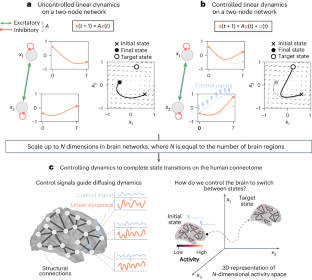研究结构连接体动态的网络控制理论管道。
IF 13.1
1区 生物学
Q1 BIOCHEMICAL RESEARCH METHODS
引用次数: 0
摘要
网络控制理论(NCT)是一种简单而强大的工具,用于研究网络拓扑结构如何影响和制约系统动力学。与其他结构-功能耦合方法相比,网络控制理论的优势在于它能够预测外部控制信号的模式,从而以理想的方式改变系统的动力学。NCT 在神经科学领域的一个有趣发展是应用于研究行为和心理健康症状。迄今为止,NCT 已通过验证,可用于研究人类结构连接组的不同方面。NCT 的输出可在整个发育阶段进行监测,以研究连接组拓扑对神经动态的影响,并分别测试经验数据集与大脑功能和刺激的一致性。在这里,我们提供了一个综合管道,通过以下两个程序将 NCT 应用于结构连接组。主要程序侧重于计算与特定神经活动状态之间转换相关的控制能量。第二个程序侧重于计算平均可控性,该指标反映了节点控制系统动态的一般能力。我们提供了将 NCT 输出与空网络模型进行比较的建议,并通过基于 Python 的软件包 "network control theory for python "进一步支持这种方法。本协议中的程序适合具有网络神经科学背景和动力系统理论经验的用户。本文章由计算机程序翻译,如有差异,请以英文原文为准。


A network control theory pipeline for studying the dynamics of the structural connectome
Network control theory (NCT) is a simple and powerful tool for studying how network topology informs and constrains the dynamics of a system. Compared to other structure–function coupling approaches, the strength of NCT lies in its capacity to predict the patterns of external control signals that may alter the dynamics of a system in a desired way. An interesting development for NCT in the neuroscience field is its application to study behavior and mental health symptoms. To date, NCT has been validated to study different aspects of the human structural connectome. NCT outputs can be monitored throughout developmental stages to study the effects of connectome topology on neural dynamics and, separately, to test the coherence of empirical datasets with brain function and stimulation. Here, we provide a comprehensive pipeline for applying NCT to structural connectomes by following two procedures. The main procedure focuses on computing the control energy associated with the transitions between specific neural activity states. The second procedure focuses on computing average controllability, which indexes nodes’ general capacity to control the dynamics of the system. We provide recommendations for comparing NCT outputs against null network models, and we further support this approach with a Python-based software package called ‘network control theory for python’. The procedures in this protocol are appropriate for users with a background in network neuroscience and experience in dynamical systems theory. This protocol describes a comprehensive framework for applying network control theory to the human structural connectome to study its topology and show how that topology affects the dynamics of neural activity states, using a software package written in Python.
求助全文
通过发布文献求助,成功后即可免费获取论文全文。
去求助
来源期刊

Nature Protocols
生物-生化研究方法
CiteScore
29.10
自引率
0.70%
发文量
128
审稿时长
4 months
期刊介绍:
Nature Protocols focuses on publishing protocols used to address significant biological and biomedical science research questions, including methods grounded in physics and chemistry with practical applications to biological problems. The journal caters to a primary audience of research scientists and, as such, exclusively publishes protocols with research applications. Protocols primarily aimed at influencing patient management and treatment decisions are not featured.
The specific techniques covered encompass a wide range, including but not limited to: Biochemistry, Cell biology, Cell culture, Chemical modification, Computational biology, Developmental biology, Epigenomics, Genetic analysis, Genetic modification, Genomics, Imaging, Immunology, Isolation, purification, and separation, Lipidomics, Metabolomics, Microbiology, Model organisms, Nanotechnology, Neuroscience, Nucleic-acid-based molecular biology, Pharmacology, Plant biology, Protein analysis, Proteomics, Spectroscopy, Structural biology, Synthetic chemistry, Tissue culture, Toxicology, and Virology.
 求助内容:
求助内容: 应助结果提醒方式:
应助结果提醒方式:


